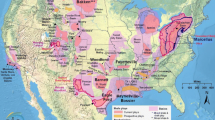Abstract
The development and effective use of natural resources is essential for meeting crucial societal needs and for the economic development of a nation. Discussed here is the case of hydraulic fracturing which is used to fracture underground formations to recover natural gas and oil. Described in the article are economic benefits and environmental and human health implications of this technology; views on these aspects rapidly become controversial. Presented here is a consensus building paradigm to address and mitigate controversies related to the implementation of this technology.
Similar content being viewed by others
References
Allen DT, Torres VN, Thomas J, Sullivan DW, Harrison M, Hendler A, Herndon SC, Kolb CE, Fraser MP, Hill DA, Lamb BK, Miskimins J, Sawyer RF, Seinfeld JH (2013) Measurement of methane emissions at natural gas production sites in the United States. Proc Natl Acad Sci 10(44):17768–17773. doi:10.1073/pnas.1304880110
American Petroleum Institute (2010) Freeing up energy—hydraulic fracturing: unlocking America’s natural gas resources. American Petroleum Institute, Washington
Gregory KB, Vidic RD, Dzombak DA (2011) Water management challenges associated with the production of shale gas by hydraulic fracturing. Elem Mineral Soc Am 7(3):181–186
Guelpa P (2013) Proceedings National Academy of Sciences, PNAS, 24 June 2013
Jain RK, Urban LV, Balbach HE, Webb MD (2012) Handbook of environmental engineering assessment. Elsevier, New York
King GE (2012) “Hydraulic Fracturing 101” SPE Hydraulic Fracturing Technology Conference, Society of Petroleum Engineers, Paper 15296
Moniz EJ (2012) The future of natural gas: an interdisciplinary MIT Study. Massachusetts Institute of Technology, Cambridge
National Academy of Engineering (2010) Grand challenges for earth resources engineering. Washington
Osborn SG, Vengosh A, Warner NR, Jackson RB (2011) Methane contamination of drinking water accompanying gas well drilling and hydraulic fracturing. Proc Natl Acad Sci USA 108(20):8172–8176
Schneising O, Burrows JP, Dickerson RR, Buchwitz M, Reuter M, Bovensmann H (2014) Remote sensing of fugitive methane emissions from oil and gas production in North American tight geologic formations. Earth Future. doi:10.1002/2014EF000265
Schultze CL (1977) The public use of private interest. Brookings Institution, Washington
Sikdar SK (2013) Resurgence of fossil fuels? Clean Technol Environ Policy 15:203–204
Spencer T, Sartor O, Mathieu M (2014) Unconventional wisdom: an economic analysis of US shale gas and implications for the EU. Institute for Sustainable Development and International Relations (IDDRI), Paris, No. 02/14
Stringfellow WT, Domen JK, Camarillo MK, Sandelin WL, Borglin S (2014) Physical, chemical, and biological characteristics of compounds used in hydraulic fracturing. J Hazard Mater 275:37–54
U.S. Congress Committee on Energy and Commerce Report (2011) Chemicals used in hydraulic fracturing
Weinhold R (2012) Unknown quantity: regulating radionuclides in tap. Environ Health Perspect 120(9):a350
Wigley TML (2011) Coal to gas: the influence of methane leakage. Clim Change 108:601–608
Acknowledgments
I want to express my deep gratitude to the publisher, Springer, the Editor-in-Chief Dr. Subhas Sikdar, members of the Journal editorial board, authors, and paper referees for giving me the opportunity to serve as a Co-Editor-in-Chief of this journal for over 15 years.
Author information
Authors and Affiliations
Corresponding author
Rights and permissions
About this article
Cite this article
Jain, R. Natural resource development for science, technology, and environmental policy issues: the case of hydraulic fracturing. Clean Techn Environ Policy 17, 3–8 (2015). https://doi.org/10.1007/s10098-014-0856-y
Received:
Accepted:
Published:
Issue Date:
DOI: https://doi.org/10.1007/s10098-014-0856-y




